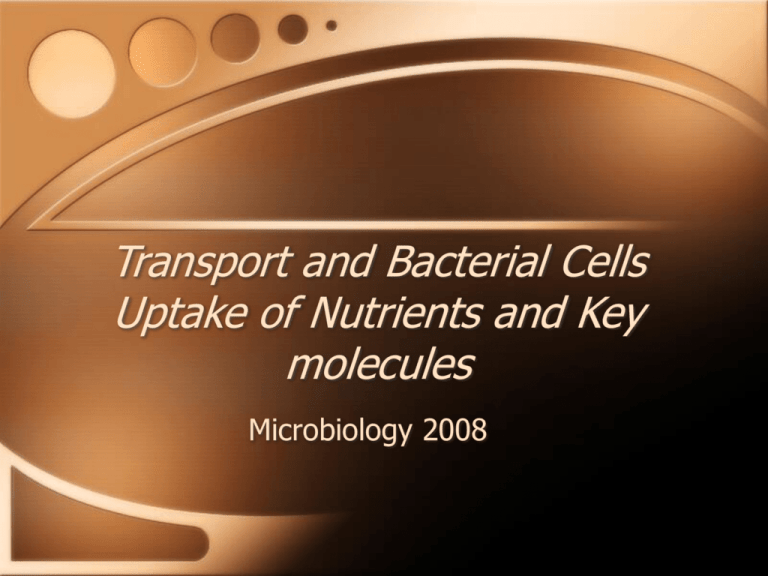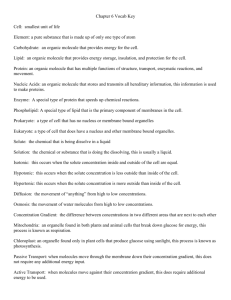Transport in Bacterial Cells
advertisement

Transport and Bacterial Cells Uptake of Nutrients and Key molecules Microbiology 2008 What molecules are needed by the cell • Carbon source( CO2, CH4, organic molecules) • Nitrogen source( nitrogen compounds) amino acids , ammonia or ammonium • Energy source Passive Transport • A few molecules that are small can pass through the phospholipid bilayer by the process of diffusion • Passive transport does not require an energy input Passive Transport • The process of diffusion occurs when molecules or ions move from an area of greater concentration to an area of lower concentration • The movement is down the concentration gradient Diffusion • Slow process • Based upon the free energy of the molecules themselves • Very small molecules such as O2 and CO2 move in this manner Rate of diffusion • The rate of diffusion is determined by the difference in concentration of the nutrients or molecules on the outside and the inside of the membrane Osmosis • The movement of water from an area of higher concentration to an area of lower concentration Concentration • The amount of solute dissolved in an ml or Liter( known volume) of solvent • Can be measured in moles per 1000 g solvent( water) which is referred to as molality(m) • Can be measured in % solute/solution • Can be measured in Molarity – moles per liter of solution( M) Water Potential • Higher potential energy of water • Higher concentration of water molecules that have free energy of movement Osmosis and cell- membranescomparative terms • Hypertonic – refers to an environment with higher salt concentration and lower water potential • Hypotonic – higher water concentration ( water potential) and lower solute Isotonic – equal concentration of solute on both sides of a membrane Plasmolysis and Recovery • Lysis of cell wall Animations for classroom • http://www.wiley.com/legacy/college/boyer/0 470003790/animations/membrane_transport/ membrane_transport.htm Membrane Proteins and Transport Channels- moves one molecule in one direction across the membrane without the expenditure of energy • Ions and larger molecules can also diffuse • Many of these move through proteins that have a hydrophilic interior or core • They move from high concentration to an area of lower concentration • No energy is utilized • Channels are specific for just one ion or molecule Channels • http://www.cellsalive.com/channels.htm Membrane Facilitated diffusion • Facilitated diffusion is a type of diffusion which uses a transport molecule . • Permease are proteins which are embedded in the cell membrane • They assist in the movement of other molecules across the membrane • This is a speedier process than regular diffusion, but again is highly specific • No energy is spent in the process Facilitated Diffusion Aquaporins • A major permease in bacteria is an aquaporin that helps to move water in and out of the cell MIPs - Major Intrinisic proteins • Group of proteins- They facilitate transport by changining their shape or conformation when they pick up the molecule • When they move the molecule to the opposite side of the membrane they again change their shape upon release of the molecule they have transported Active Transport http://staff.jccc.net/PDECELL/cells/activet.html • Transport of molecules and ions against the concentration gradient from low concentration to high concentration • Requires the input of energy in the form of ATP • ATP ADP + P + energy ATP Binding Cassette Transporters( ABC Transporters) • Transporters are proteins that span the membrane • They bind to the ATP and hydrolyze or break down ATP to produce energy Symports • Move two molecules or a molecule and an ion in the same direction • Both can move in the same direction • Usually one moves with the concentration gradient • The other is pulled across the membrane against the concentration gradient by the free energy of the molecules that are moving Antiports • Two molecules are moving across the membrane • One molecule is moving against the concentration gradient in one direction • The other is moving with the concentration gradient Siderophores • Iron is a very important nutritional ion for the bacterial cell • Siderophores are small molecules that are able to form a complex with iron to bring it into the cell Porins • Porins are proteins located in the outer cell membranes ( the outer lipid membane) • They are responsible for moving molecules through the outer membrane in Gram negative bacteria • Molecules are moved into the periplasmic space and then into the cell Group Translocation • In this process the molecules are modified as they are transported across the cell membrane or into the cell • Group Translocation is a type of active transport • Many vital molecules are brought into the cell in this manner Group Translocation • Group Translocation involves the transfer of a phosphate group • This energizes the molecule so that it can be transported into the cell Protein Transport Systems in the Cell Membrane





